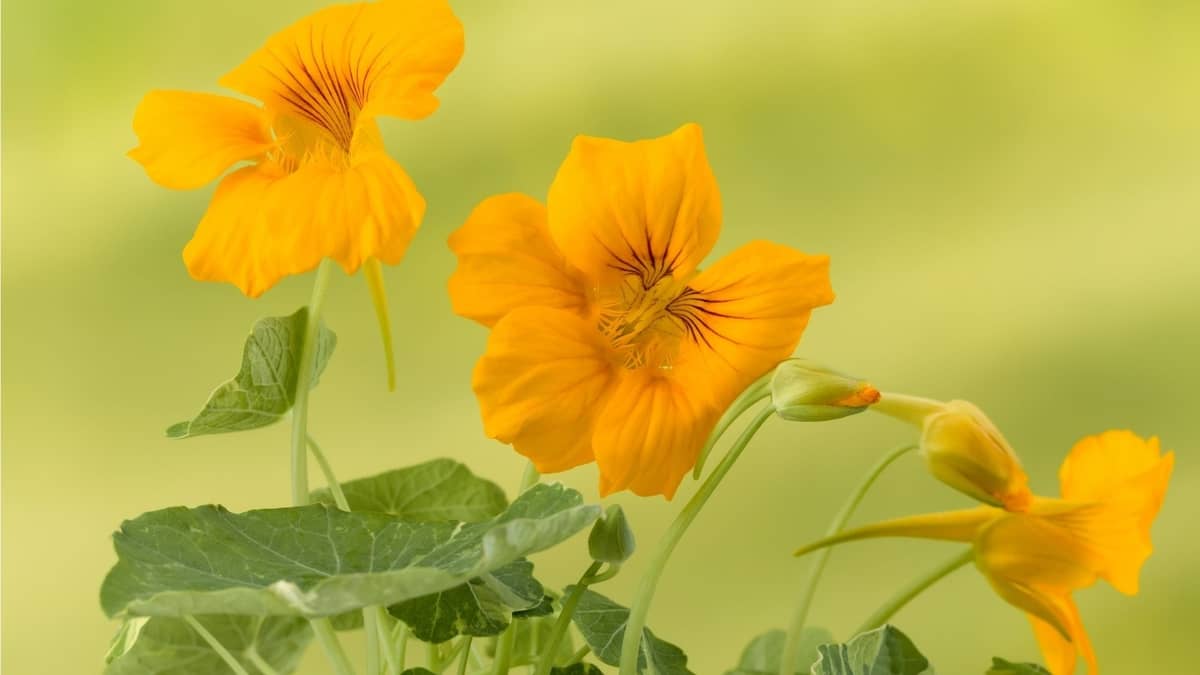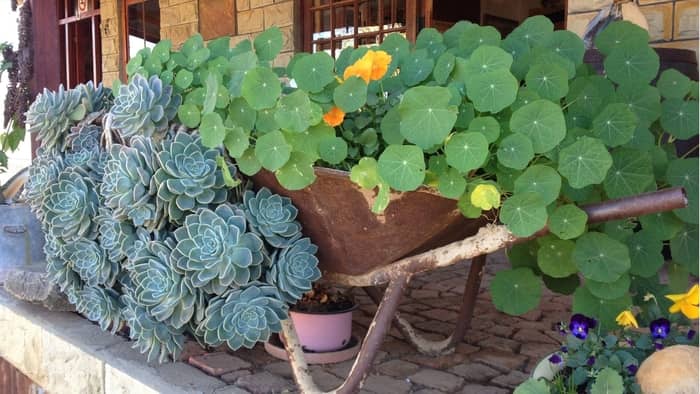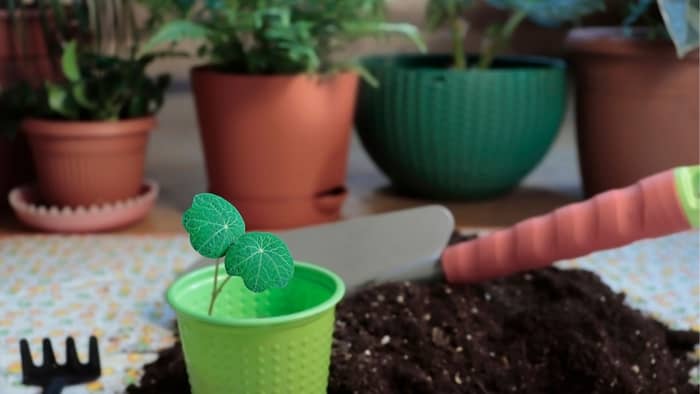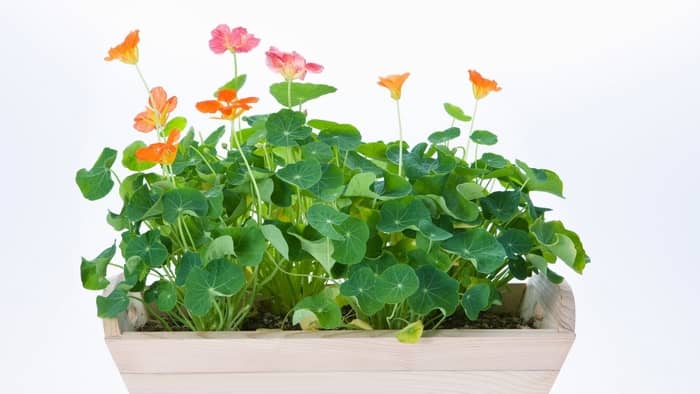Last Updated on December 31, 2021 by Guillermina
Wondering can you grow nasturtiums indoors? Click to learn all about this unique and delicious houseplant.
Nasturtiums originate from the high Andean mountains of Peru. These bright, bold, and cheerful flowers are among the easiest to grow. Did you know that Nasturtium plants are completely edible?
Wondering can you grow nasturtiums indoors? Here is all you need to know about growing this unique houseplant.
Description
Nasturtium plants originate from a genus in the family Tropaeolaceae, which contains about 80 species of herbaceous plants, as well as annuals and perennials. This plant is native to the Andes Mountains of Bolivia, Columbia, and Peru.
Nasturtium plants are recognizable by their rich, saturated, jewel-toned colors. There are varieties of nasturtiums for almost every purpose in the garden, from varieties intended for borders and edges to those that climb dramatically along walls.
They have unique trumpet-shaped flowers with five petals. As for the colors, they are deep and intense in different shades ranging from cream, fuchsia, mahogany, orange, pink, red, to white, and yellow.
They owe their name to the Swedish botanist Carl Linnaeus. He stated that their shape reminded him of a Roman trophy, round leaves on military shields, and deep red flowers looking on blood-stained helmets. Nasturtiums were introduced to North America in the early 1800s, where they soon gained popularity thanks to their beautiful flowers.
In addition, their feature is edibility! Their leaves, flowers, and seedpods have a peppery, almost mustard-like taste. Therefore, they are a favorite addition to salads. Also, the seed pods can also be pickled and used like capers.
Varieties of Nasturtiums
These are the most popular types of nasturtium houseplant.
Alaska Series – a bushy dwarf plant with heavily variegated foliage and blossoms above the foliage.
Jewel’ Series – bushy dwarf plants with double and semi-double blooms, its flowers usually tend to get lost under the foliage.
Peach Melba – bushy dwarf plants with semi-double buttery yellow flowers splashed with orange-red centers.
Canary Creeper – a perennial vine with yellow flowers that look like a bird’s wings.
When To Start Nasturtium Seeds Indoors?
Nasturtium seedlings can be sown directly in the garden or started indoors. Most important of all is to remember that their fragile roots are sensitive to transplanting. So, sowing is much better than transplanting.
As for indoor cultivation, it is recommended to start seeds 2 to 4 weeks before the last spring frost.
Planting The Seeds
Step 1
Since growing indoors also means limited space, try to find dwarf or compact nasturtium seeds that won’t take up as much space. Some varieties can grow tendrils that are up to 20 feet (6.1 m) long.
Therefore, it would be good to avoid nasturtium seedlings that have the word “trailing” written on the bag. Such varieties grow and spread the most. The best options for growing indoors are Alaska and Peach Melba.
Step 2
Fill a small bowl with just enough water to submerge the seeds completely and allow them to soak for up to 8 hours. This increases the likelihood of germination. In addition, you can scratch their outer shells with a garden knife to help them germinate.
Step 3
The best thing about nasturtium houseplants is that they are very adaptable and can survive in any type of potting soil. Stir your potting mix with 1 treatment of fertilizer to help the soil absorb nutrients more easily.
Step 4
Choose a container that has drainage holes or make them yourself if there are none. Then, put a mixture of potting soil and fertilizer in the pot. Don’t forget to leave about 1 in (2.5 cm) of space between the top of the soil and the pot’s rim.
Step 5
Push your finger into the soil in the middle of the pot to make a hole in which you will sow 1 seed. The recommended depth is 1⁄2 in (1.3 cm). After that, refill the hole with soil and lightly compact it.
Try to avoid planting multiple nasturtiums in one pot as this will compromise their growth.
Step 6
Water the soil thoroughly while taking care not to disturb the seed, otherwise, it will not be able to establish roots. Continue watering until you notice it coming out of the drainage holes. Avoid excessive watering as this can damage the plant.
Step 7
Look for a window facing east or south on which you will place the pot. Keep the temperature above 55 ° F (13 ° C), also choose an area that gets about 6 hours of light. If you don’t have a sunny window in your home, it would be good to use fluorescent grow lights.
Step 8
Observe the pot carefully for the next few days. After about 10 days you should notice small green shoots coming up from the soil. If you don’t notice it even a few days later, you may have planted bad seeds that couldn’t germinate. If this is the case with you, simply dig it up and plant new seeds in their place.
How To Care For Nasturtium Houseplant
Push your finger 2 inches (5.1 cm) into the soil; if you notice dryness, it’s time to water. Avoid too frequent and excessive watering as they lead to seed rot.
They generally prefer average humidity levels. Therefore, they can struggle in very dry or very humid conditions.
Regularly cut faded / dead flowers to prolong flowering.
They may need to be pruned periodically during the growing season to encourage new leaf production.
During high temperatures, these flowers experience heat stress that affects their taste.
In Conclusion
This unique greenery with its vibrant flowers is an ideal choice for growing in containers. Best of all, their leaves are edible. The young flower buds and unripe seeds taste surprisingly good and may be used in sandwiches and salads.
With only a hint of care and attention, these fast-spreading plants can adorn your living space. They thrive in poor soil, don’t like fertilization, but love sunbathing.
That would be it! We hope you found this article on “can you grow nasturtiums indoors” useful. Let us know in the comments below.
Click to learn more about Tips For Growing Avocado Indoors Successfully




